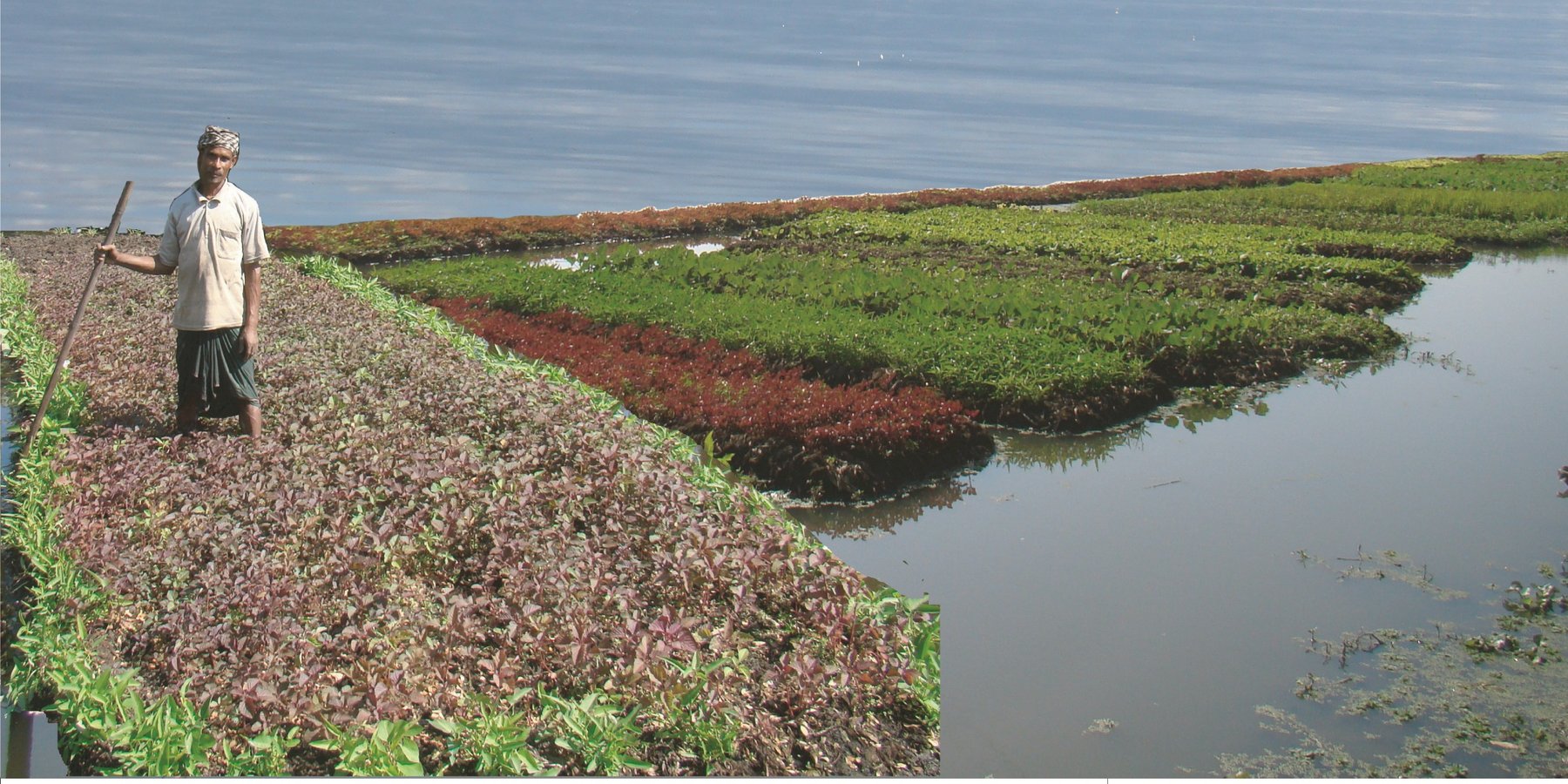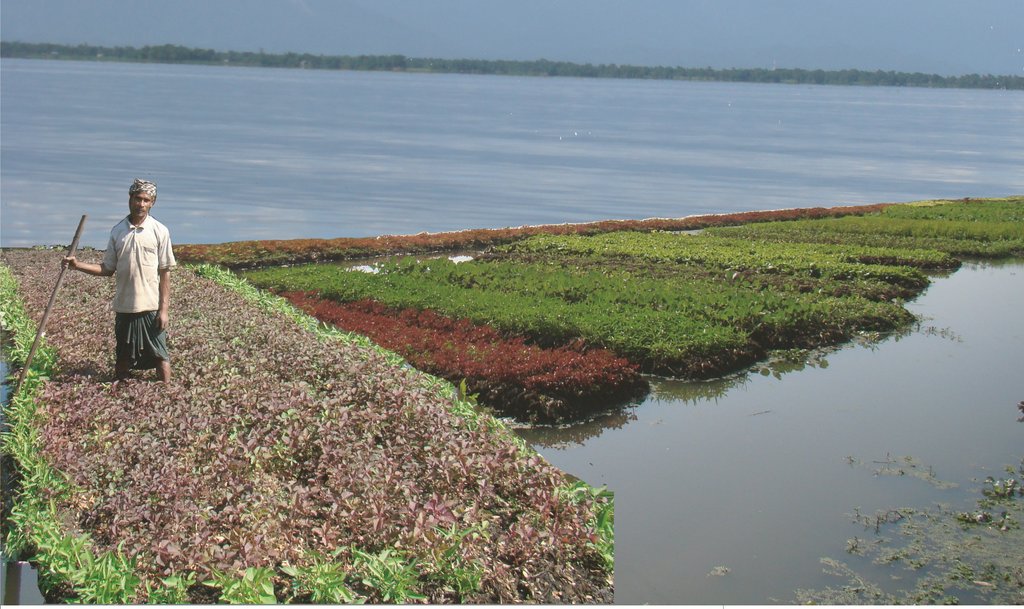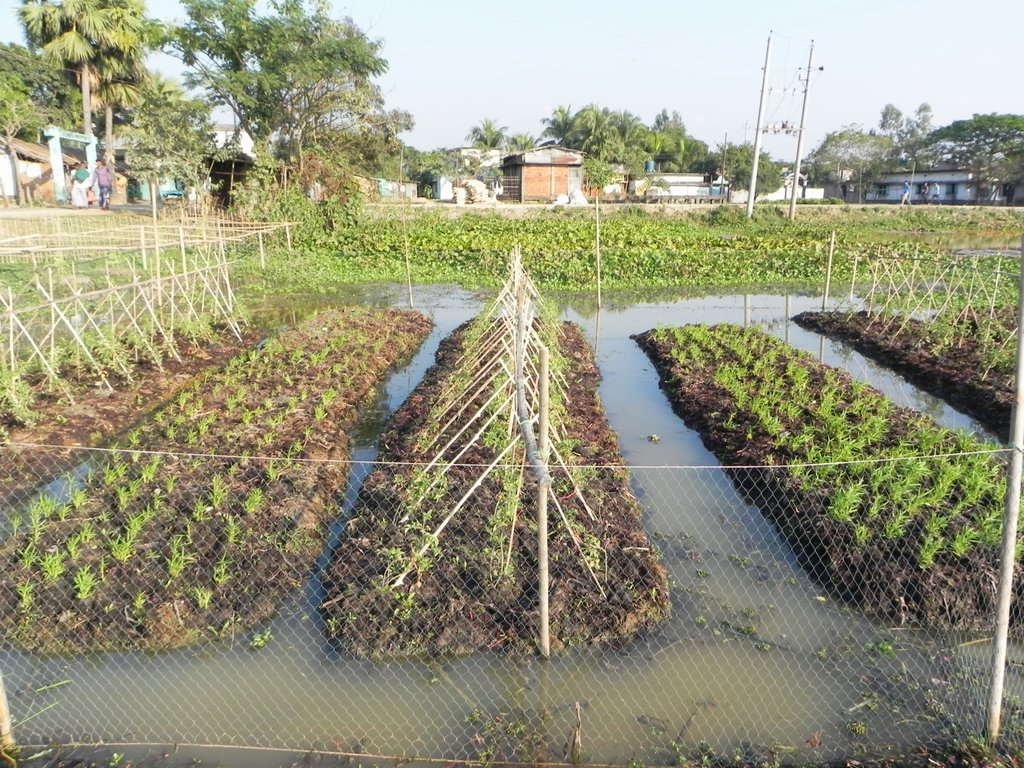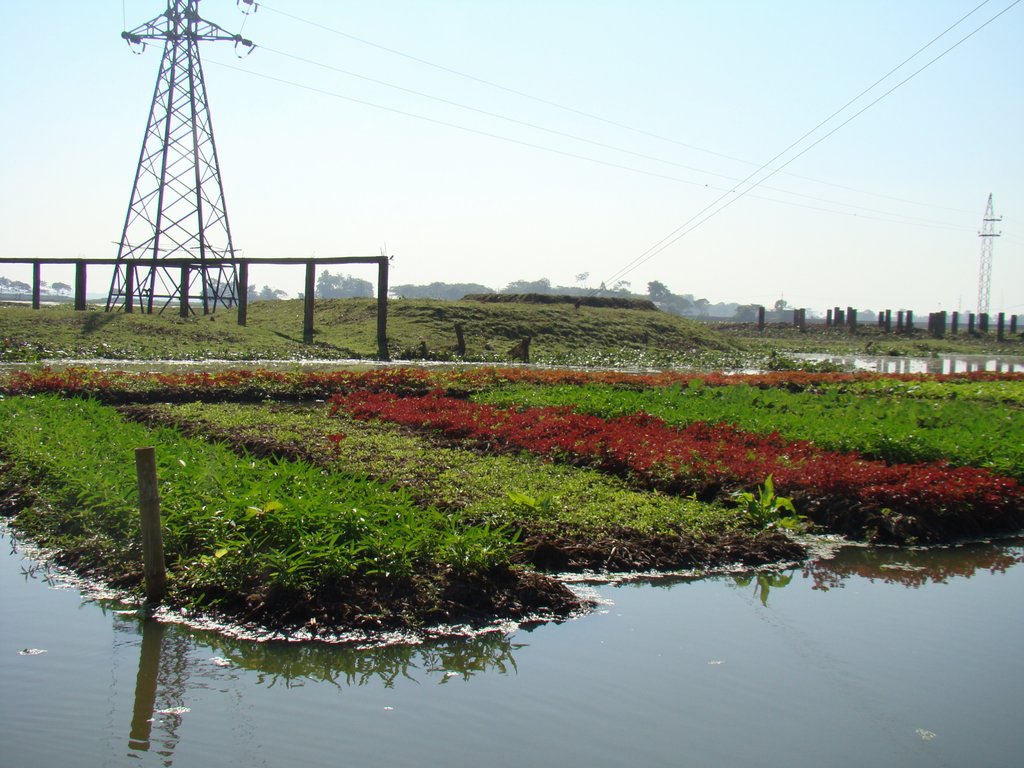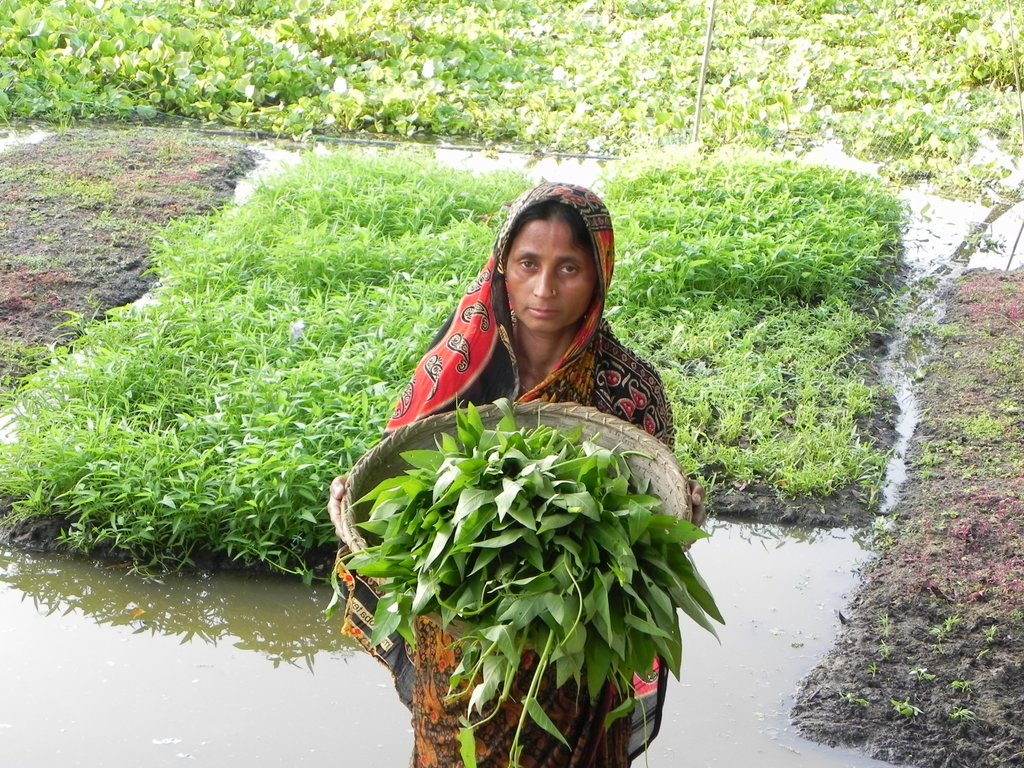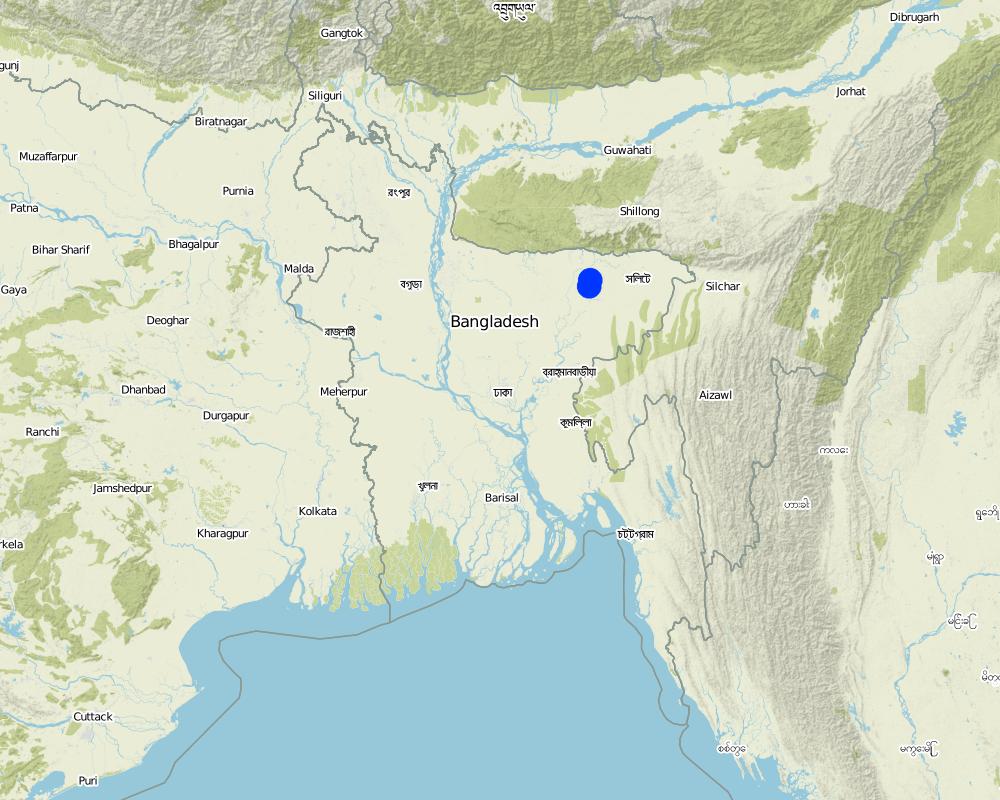Floating Garden [ប្រទេសបង់ក្លាដែស]
- ការបង្កើត៖
- បច្ចុប្បន្នភាព
- អ្នកចងក្រង៖ Shamim Ahamed
- អ្នកកែសម្រួល៖ Eveline Studer
- អ្នកត្រួតពិនិត្យច្រើនទៀត៖ Alexandra Gavilano, Alvin Chandra
"Baira" or "Dhap", floating bed
technologies_620 - ប្រទេសបង់ក្លាដែស
ពិនិត្យមើលគ្រប់ផ្នែក
ពង្រីកមើលទាំងអស់ បង្រួមទាំងអស់1. ព័ត៌មានទូទៅ
1.2 ព័ត៌មានលម្អិតពីបុគ្គលសំខាន់ៗ និងស្ថាប័នដែលចូលរួមក្នុងការវាយតម្លៃ និងចងក្រងឯកសារនៃបច្ចេកទេស
បុគ្គលសំខាន់ម្នាក់ (ច្រើននាក់)
អ្នកជំនាញឯកទេស SLM:
Hasan Md. Zahid
+880 2 55052051-3 / +880 1716388648
zahid.hasan@helveas.org / zahidforestry@gmail.com
HELVETAS Swiss Intercooperation
House-13/A NE (K), Road-83, Gulshan-2, Dhaka, Post code-1212, Bangladesh
ប្រទេសបង់ក្លាដែស
ឈ្មោះគម្រោងដែលបានចងក្រងឯកសារ/ វាយតម្លៃលើបច្ចេកទេស (បើទាក់ទង)
Book project: where people and their land are safer - A Compendium of Good Practices in Disaster Risk Reduction (DRR) (where people and their land are safer)ឈ្មោះអង្គភាពមួយ (ច្រើន) ដែលបានចងក្រងឯកសារ/ វាយតម្លៃបច្ចេកទេស (បើទាក់ទង)
HELVETAS (Swiss Intercooperation)1.3 លក្ខខណ្ឌទាក់ទងទៅនឹងការប្រើប្រាស់ទិន្នន័យដែលបានចងក្រងតាមរយៈ វ៉ូខេត
តើពេលណាដែលទិន្នន័យបានចងក្រង (នៅទីវាល)?
05/10/2016
អ្នកចងក្រង និង(បុគ្គលសំខាន់ៗ)យល់ព្រមទទួលយកនូវលក្ខខណ្ឌនានាទាក់ទងទៅនឹងការប្រើប្រាស់ទិន្នន័យដែលបានចងក្រងតាមរយៈវ៉ូខេត:
បាទ/ចា៎
1.4 សេចក្តីប្រកាសស្តីពីចីរភាពនៃការពណ៌នាពីបច្ចេកទេស
តើបច្ចេកទេសដែលបានពណ៌នានេះមានបញ្ហាដែលផ្តោតលើការធ្លាក់ចុះគុណភាពដី, បើដូច្នេះវាមិនអាចត្រូវបានប្រកាសថាជាបច្ចេកទេសនៃការគ្រប់គ្រងប្រកបដោយចីរភាពទេ?
ទេ
មតិយោបល់:
Context specific environmentally friendly technology
2. ការពណ៌នាពីបច្ចេកទេស SLM
2.1 ការពណ៌នាដោយសង្ខេបពីបច្ចេកទេស
និយមន័យបច្ចេកទេស:
Floating Garden is a traditional technology, practiced in the southern parts of Bangladesh locally called “Baira” or “Dhap”. The technology allows producing crops, vegetables and seedlings in areas where farming land is scarce and where the land is flodded or water logged for more than six months in a year.
2.2 ការពណ៌នាលម្អិតពីបច្ចេកទេស
ការពណ៌នា:
Floating gardensa are a traditional practice in south central districts of Bangladesh since long time, and has been promoted by government extension agency and development organizations in different parts of the country with technical improvements. With this technology, crops (mainly vegetables) are cultivated on floating garden beds in areas where the land inundated for more than six months in a year.
Establishment:
The basic input and main raw material to prepare the floating garden bed are water hyacinths (Eichhornia crassipes). In some cases bamboo sticks are also used to make the floating beds more resistant. The floating gardens are of different size, with a standard size per bed during preparation of 1.5 - 1.8 meter wide, 10 -11 meter long and 1 - 1.3 meter above water level. However, considering local context- such as wave action, size of water body, presence of a wetland - the bed size may vary, also depending on whether compost is added on the top. The establishment of the floating gardens are very cheap in terms of raw material and require mainly human manual labour for its establishment, without material costs for maintenance.
The garden can be used for two purposes: for vegetable production and for vegetable seedling production.
In water logged areas (where water remains for the whole year) floating beds are mainly used for vegetable production. Almost any type of vegetables can be grown in the floating bed. Production of leafy vegetables proofed to be most profitable. In addition, all types of vegetable seedlings and rice seedlings can produced in floating garden based on demand. In other areas, which are only inundated temporarily, floating garden can be used for both vegetable and seedling production. In this second case seedlings can be transfered from the garden to the fields on the main land immediately after receding of the water. This practice can save 2 to 3 weeks time of vegetable or rice production in winter season. This is a crucial advantage considering the trend to shorter growing periods due to unpredictable early spring rains.
A key advantage of floating gardening is the fact that heavy rainfalls usually do not have any negative effect on culture of the floating gardens, which are a highly effective and beneficial risk reduction and climate change mitigation technology. Floating gardens can further contribute to food security and improved nutrition for poor households, and it is a source for additional income by making use of cheap and abundant local input resources. Different NGOs improved and promoted this technology in north-west and north-east parts of Bangladesh since 2000. Since 2011 also the public agricultural extension agencies promote this technology.
As an overall goal this technology aims at protecting people’s assets for agricultural production from damages due to seasonal floods and provide options for alternative income resources. The floating garden technology is designed as measure to protect effectively from yearly floods. It might not be robust enough for extreme events with heavy storms and waves. Smaller repairing can be done by the owners themselves. In case of major damages the beds can be replaced by new ones, since the investment costs are very low. In the shallow areas the floating beds may become ordinary garden beds or fields during dry season.
2.3 រូបភាពនៃបច្ចេកទេស
2.4 វីដេអូនៃបច្ចេកទេស
ការពណ៌នាសង្ខេប:
This video was developed for the capitalization of practical experience and instructive training materials. The short movie describes step by step the establishment and the benefits of the floating gardens. In a short interview governmental and other local partners share their positive experience of the technology and describe how the technology is mainstreamed by Government agencies.
The video is available online with following link: https://youtu.be/AK_qTm2pUsw
កាលបរិច្ឆេទ:
29/02/2012
ទីតាំង:
Sunamganj, Bangladesh
ឈ្មោះអ្នកថតវីឌីអូ:
HELVETAS Swiss Intercooperation
ការពណ៌នាសង្ខេប:
The video documentary was prepared to capitalise and diseminate the experience of the Floating Gardens as an innovative technology for vegetable cultivation in wetlands.
កាលបរិច្ឆេទ:
01/06/2012
ទីតាំង:
Sunamganj, Bangladesh
ឈ្មោះអ្នកថតវីឌីអូ:
HELVETAS Swiss Intercoopartion
2.5 ប្រទេស/តំបន់/ទីតាំងកន្លែង ដែលបច្ចេកទេសត្រូវបានអនុវត្ត និងបានគ្រប់ដណ្តប់ដោយការវាយតម្លៃនេះ
ប្រទេស:
ប្រទេសបង់ក្លាដែស
តំបន់/រដ្ឋ/ខេត្ត:
Sylhet division, Sunamganj district
បញ្ជាក់បន្ថែមពីលក្ខណៈនៃទីតាំង:
Paschim Pagla, Patharia and Shimulbak unions under South Sunamganj sub-district, Charnarchar and Rajanagar unions under Derai sub-district
មតិយោបល់:
More than 1000 floating beds have been prepared in 8 sub-districts of Sunamganj district in northeastern Bangladesh and documented accordingly. HELVETAS supported government agencies (District Administration and Department of Agricultural Extension-DAE) to document and promote the technology further.
Map
×2.6 កាលបរិច្ឆេទនៃការអនុវត្ត
ប្រសិនបើមិនច្បាស់ឆ្នាំ សូមបញ្ជាក់កាលបរិច្ឆេទដែលប្រហាក់ប្រហែល:
- តិចជាង 10ឆ្នាំមុន (ថ្មី)
2.7 ការណែនាំពីបច្ចេកទេស
សូមបញ្ជាក់តើបច្ចេកទេសត្រូវបានណែនាំឱ្យអនុវត្តដោយរបៀបណា:
- តាមរយៈគម្រោង / អន្តរាគមន៍ពីខាងក្រៅ
មតិយោបល់ (ប្រភេទនៃគម្រោង ។ល។):
The technology was first piloted through implementation of “Livelihoods, Empowerment and Agroforestry (LEAF)” project. Later on, the technology was expanded through implementation of “Agricultural Innovation for Eliminating Extreme Poverty” (AIEEP 2009-2012) and through Unnoti -Prosperity in Haor project (2013-2016).
3. ចំណាត់ថ្នាក់នៃបច្ចេកទេស SLM
3.1 គោលបំណងចម្បង (១ ឬច្រើន) នៃបច្ចេកទេសនេះ
- ធ្វើឱ្យប្រសើរឡើងនូវផលិតកម្ម
- កាត់បន្ថយហានិភ័យនៃគ្រោះមហន្តរាយ
- បន្ស៊ាំទៅនឹងការប្រែប្រួលអាកាសធាតុ/គ្រោះមហន្តរាយ និងផលប៉ះពាល់របស់វា
- បង្កើតផលប្រយោជន៍សេដ្ឋកិច្ច
- បង្កើតផលប្រយោជន៍សង្គម
- improve household food security / nutrition
3.2 ប្រភេទដីប្រើប្រាស់មួយប្រភេទ (ច្រើនប្រភេទ) ដែលបានអនុវត្តបច្ចេកទេស

ដីដាំដំណាំ
- ដំណាំប្រចាំឆ្នាំ
ដំណាំចម្បង (ដំណាំកសិ-ឧស្សាហកម្ម និងដំណាំស្បៀង) :
Vegetables and seedlings

ផ្លូវទឹក ផ្ទៃទឹក ដីសើម
- វាលភក់ ដីសើម
ផលិតផល/សេវាកម្មចម្បង:
Vegetable and Seedling
ប្រសិនបើដីមានការប្រែប្រួលបន្ទាប់ពីការអនុវត្តបច្ចេកទេស សូមបញ្ជាក់ពីការប្រើប្រាស់ដីមុនពេលអនុវត្តន៍បច្ចេកទេស:
earlier these wetland areas were mainly fallow (not used for any productive purpose). During monsoon season, the waterbodies naturally count on fish reserves, which are captures by local farmers including landless poor. Water hyacinth of these wetlands were partially used as fodder, though most of it was decomposed naturally without use.
3.3 ព័ត៌មានបន្ថែមអំពីអ្នកប្រើប្រាស់ដី
ផ្សេងៗ (ឧ. ក្រោយពីទឹកជំនន់):
- post-flooding
មតិយោបល់:
Floating gardens are prepared on the water body, hence can absorb sufficient water without additional irrigation.
ចំនួនសារដែលដាំដំណាំក្នុងមួយឆ្នាំ:
- 2
សូមបញ្ជាក់:
Winter and early Summer
3.4 ក្រុម SLM ដែលបច្ចេកទេសស្ថិតនៅក្នុង
- ធ្វើឱ្យប្រសើរឡើងគម្របដី/ ដំណាំគម្របដី
- ការគ្រប់គ្រង/ ការការពារតំបន់ដីសើម
- គេហសួន
3.5 ការសាយភាយនៃបច្ចេកទេស
បញ្ជាក់ពីការសាយភាយនៃបច្ចេកទេស:
- អនុវត្តនៅកន្លែងជាក់លាក់មួយ/ ប្រមូលផ្តុំនៅតំបន់តូចៗ
3.6 វិធានការ SLM ដែលបញ្ចូលនូវបច្ចេកទេស

វិធានការក្សេត្រសាស្ត្រ
- A5: ការគ្រប់គ្រងគ្រាប់ពូជ បង្កើនប្រភេទពូជ

វិធានការរចនាស័ម្ពន្ធ
- S11: ផ្សេងៗ

វិធានការគ្រប់គ្រង
- M1: ការផ្លាស់ប្តូរប្រភេទដីប្រើប្រាស់
មតិយោបល់:
floating beds, which are adapted to changing water levels (floods).
change of land/water management from pure wetlands to gardens.
3.7 កំណត់ប្រភេទនៃការធ្លាក់ចុះគុណភាពដីសំខាន់ៗដែលបច្ចេកទេសនេះបានដោះស្រាយ

ការបាត់បង់ទឹក
- Hs: ការប្រែប្រួលបរិមាណទឹកនៅលើផ្ទៃដី
មតិយោបល់:
More frequent and severe seasonal floodings
3.8 ការពារ កាត់បន្ថយ ឬស្តារឡើងវិញនៃការធ្លាក់ចុះគុណភាពដី
បញ្ជាក់ពីគោលដៅរបស់បច្ចេកទេស ដែលផ្តោតទៅការធ្លាក់ចុះគុណភាពដី:
- ការកាត់បន្ថយការធ្លាក់ចុះគុណភាពដី
- ការបន្ស៊ាំទៅនឹងការធ្លាក់ចុះគុណភាពដី
មតិយោបល់:
The technology is used to adapt to natural seasonal flooding, to prevent damages caused by floods by using wet lands for crop production.
4. បច្ចេកទេសជាក់លាក់ សកម្មភាពអនុវត្ត ធាតុចូល និងថ្លៃដើម
4.1 គំនូសបច្ចេកទេសនៃបច្ចេកទេសនេះ
4.2 លក្ខណៈពិសេសនៃបច្ចេកទេស/ ពណ៌នាពីគំនូរបច្ចេកទេស
• Dimensions: The floating beds are of different size. Standard size at the time of preparation 1.5 - 1.8 meter wide, 10-11 meter long and 1.0-1.3 meter height.
• Floating beds should not cover more than 30% area of the respective water body (wetland area) in order to keep enabling environment for other aquatic resources (e.g. fishes).
• Construction material used: The basic and main ingredient/material for the preparation of the floating garden are water hyacinths (Eichhornia crassipes). In some cases, bamboo sticks are also used to increase its resistance. If available, composts may be applied on the top of floating beds, though not compulsory.
4.3 ព័ត៌មានទូទៅដែលពាក់ព័ន្ធនឹងការគណនាធាតុចូល និងថ្លៃដើម
កំណត់របៀបនៃការគណនាថ្លៃដើម និងធាតុចូល:
- ក្នុងតំបន់អនុវត្តបច្ចេកទេស
កំណត់ទំហំ និងឯកត្តាផ្ទៃដី:
1 decimal for 5 floating beds
បើសិនប្រើឯកតាតាមផ្ទៃដីក្នុងមូលដ្ឋាន សូមបញ្ជាក់ពីខ្ជាតប្តូរទៅជាហិកតា:
1 hectare = 247 decimals
ផ្សេងៗ/ រូបិយប័ណ្ណជាតិ (បញ្ជាក់):
BDT
កំណត់ថ្លៃឈ្នួលជាមធ្យមនៃការជួលកម្លាំងពលកម្មក្នុងមួយថ្ងៃ:
1 man-day cost BDT 300 (USD 3.85)
4.4 សកម្មភាពបង្កើត
| សកម្មភាព | ប្រភេទវិធានការ | ពេលវេលា | |
|---|---|---|---|
| 1. | Bed preparation (by hired labour) | រចនាសម្ព័ន្ធ | August-September |
| 2. | Seeding, care and maintenance, harvesting | ក្សេត្រសាស្ត្រ | September-March |
មតិយោបល់:
After full harvesting of vegetable in March, the bed (decomposed water hyacinth) can be used as organic compost for other crops in cultivable land.
4.5 ថ្លៃដើម និងធាតុចូលដែលត្រូវការសម្រាប់ការបង្កើតបច្ចេកទេស
| បញ្ជាក់ពីធាតុចូល | ឯកតា | បរិមាណ | ថ្លៃដើមក្នុងមួយឯកតា | ថ្លៃធាតុចូលសរុប | % នៃថ្លៃដើមដែលចំណាយដោយអ្នកប្រើប្រាស់ដី | |
|---|---|---|---|---|---|---|
| កម្លាំងពលកម្ម | Hired labour cost for bed establishment | persons day | 10,0 | 300,0 | 3000,0 | |
| កម្លាំងពលកម្ម | Bed management cost (seeing, care, harvest ect.) | persons day | 90,0 | 300,0 | 27000,0 | 100,0 |
| សម្ភារៈដាំដុះ | Seeds per year | kg | 25,0 | 100,0 | 2500,0 | 100,0 |
| សម្ភារៈសាងសង់ | Bamboo | bamboo quantity | 2,0 | 100,0 | 200,0 | |
| សម្ភារៈសាងសង់ | Rope and lubricants | lumpsum | 1,0 | 250,0 | 250,0 | |
| ថ្លៃដើមសរុបក្នុងការបង្កើតបច្ចេកទេស | 32950,0 | |||||
4.6 សកម្មភាពថែទាំ
មតិយោបល់:
No maintenance required
4.7 កំណត់ថ្លៃដើមសម្រាប់ការថែទាំ/ សកម្មភាពរបស់បច្ចេកទេស (ក្នុងរយៈពេលមួយឆ្នាំ)
មតិយោបល់:
No specific maintenance costs during the year/season required. Small repairments are part of the labour costs of agronomic mesures to be done in paralele with care work.
4.8 កត្តាសំខាន់បំផុតដែលមានឥទ្ធិពលដល់ការចំណាយ
ពណ៌នាពីកត្តាប៉ះពាល់ចម្បងៗទៅលើថ្លៃដើម:
In case the inputs, mainly water hyacinths, are not available at the selected sites, this increases the material and/or labour costs for hyacinths to be transported from distant locations.
All indicated costs refer to yearly costs, since the beds ususally have to be restablished every year.
5. លក្ខណៈបរិស្ថានធម្មជាតិ និងមនុស្ស
5.1 អាកាសធាតុ
បរិមាណទឹកភ្លៀងប្រចាំឆ្នាំ
- < 250 មម
- 251-500 មម
- 501-750 មម
- 751-1,000 មម
- 1,001-1,500 មម
- 1,501-2,000 មម
- 2,001-3,000 មម
- 3,001-4,000 មម
- > 4,000 មម
កំណត់បរិមាណទឹកភ្លៀង (បើដឹង) ជា មីលីម៉ែត្រ:
3365,00
លក្ខណៈពិសេស/ មតិយោបល់លើរដូវភ្លៀង:
The driest month is December, with 6 mm of rain. The greatest amount of precipitation occurs in June, with an average of 712 mm.
បញ្ជាក់ឈ្មោះឯកសារយោងនៃស្ថានីយឧតុនិយម:
Sunamganj, Bangladesh (data source: www.en.climate-data.org)
តំបន់កសិអាកាសធាតុ
- សើម
The average annual temperature is 25.0 °C in Sunamganj.
5.2 សណ្ឋានដី
ជម្រាលជាមធ្យម:
- រាបស្មើ (0-2%)
- ជម្រាលតិចតួច (3-5%)
- មធ្យម (6-10%)
- ជម្រាលខ្ពស់បន្តិច (11-15%)
- ទីទួល (16-30%)
- ទីទួលចោត (31-60%)
- ទីទួលចោតខ្លាំង (>60%)
ទម្រង់ដី:
- ខ្ពង់រាប
- កំពូលភ្នំ
- ជម្រាលភ្នំ
- ជម្រាលទួល
- ជម្រាលជើងភ្នំ
- បាតជ្រលងភ្នំ
តំបន់តាមរយៈកម្ពស់ :
- 0-100 ម
- 101-500 ម
- 501-1,000 ម
- 1,001-1,500 ម
- 1,501-2,000 ម
- 2,001-2,500 ម
- 2,501-3,000 ម
- 3,001-4,000 ម
- > 4,000 ម
បញ្ជាក់ថាតើបច្ចេកទេសនេះត្រូវបានអនុវត្តន៍នៅក្នុង:
- សណ្ឋានដីផត
5.3 ដី
បើអាចសូមភ្ជាប់ការពណ៌នាពីដីឱ្យបានច្បាស់ ឬព័ត៌មានដែលអាចទទួលបាន ឧ. ប្រភេទដី, pH ដី/ ជាតិអាស៊ីត, សមត្ថភាពផ្លាស់ប្តូរកាចុង, វត្តមាននីត្រូសែន, ភាពប្រៃ ។ល។:
Not applicable for this technology as floating bed prepare on surface of water body
5.4 ទឹកដែលអាចទាញមកប្រើប្រាស់បាន និងគុណភាពទឹក
នីវ៉ូទឹកក្រោមដី:
ផ្ទៃខាងលើ
ទឹកលើដីដែលអាចទាញយកប្រើប្រាស់បាន:
លើស
គុណភាពទឹក (មិនបានធ្វើប្រត្តិកម្ម):
ទឹកសម្រាប់តែការធ្វើកសិកម្ម (ស្រោចស្រព)
តើមានបញ្ហាភាពទឹកប្រៃហូរចូលមកដែរឬទេ?
ទេ
តើទឹកជំនន់កំពុងកើតមាននៅតំបន់នេះដែររឺទេ?
បាទ/ចា៎
ភាពទៀងទាត់:
ញឹកញាប់
មតិយោបល់ និងលក្ខណៈពិសេសផ្សេងៗទៀតលើគុណភាព និងបរិមាណទឹក :
Each year seasonal monsoon flooding. However, early flash (pre monsoon flood) occur only every 3 years.
5.5 ជីវៈចម្រុះ
ភាពសម្បូរបែបនៃប្រភេទ:
- កម្រិតមធ្យម
ភាពសម្បូរបែបនៃទីជម្រក:
- កម្រិតមធ្យម
មតិយោបល់ និងលក្ខណៈពិសេសផ្សេងទៀតលើជីវចម្រុះ:
Water bodies are rich with diverse aquatic organisms
5.6 លក្ខណៈនៃអ្នកប្រើប្រាស់ដីដែលអនុវត្តបច្ចេកទេស
នៅមួយកន្លែង ឬពនេចរ :
- នៅមួយកន្លែង
ទីផ្សារនៃប្រព័ន្ធផលិតកម្ម:
- ពាក់កណ្តាលពាណិជ្ជកម្ម (ផ្គត់ផ្គង់ខ្លួនឯង/ ពាណិជ្ជកម្ម
ចំណូលក្រៅកសិកម្ម:
- 10-50% នៃចំណូល
កម្រិតជីវភាព:
- មិនល្អខ្លាំង
- មិនល្អ
ឯកជន ឬក្រុម:
- ធ្វើខ្លួនឯង/ គ្រួសារ
- ជាក្រុម/ សហគមន៍
កម្រិតប្រើប្រាស់គ្រឿងយន្ត:
- ប្រើកម្លាំងពលកម្ម
យេនឌ័រ:
- ស្ត្រី
- បុរស
អាយុរបស់អ្នកប្រើប្រាស់ដី:
- យុវវ័យ
- វ័យកណ្តាល
5.7 ទំហំផ្ទៃដីជាមធ្យមនៃដីផ្ទាល់ខ្លួន ឬជួលគេដែលបានអនុវត្តបច្ចេកទេស
- < 0.5 ហិកតា
- 0.5-1 ហិកតា
- 1-2 ហិកតា
- 2-5 ហិកតា
- 5-15 ហិកតា
- 15-50 ហិកតា
- 50-100 ហិកតា
- 100-500 ហិកតា
- 500-1,000 ហិកតា
- 1,000-10,000 ហិកតា
- > 10,000 ហិកតា
តើផ្ទៃដីនេះចាត់ទុកជាទំហំកម្រិតណាដែរ ខ្នាតតូច មធ្យម ឬខ្នាតធំ (ធៀបនឹងបរិបទតំបន់)?
- ខ្នាតតូច
5.8 ភាពជាម្ចាស់ដី កម្មសិទ្ធប្រើប្រាស់ដី និងកម្មសិទ្ធប្រើប្រាស់ទឹក
កម្មសិទ្ធប្រើប្រាស់ទឹក:
- អាស្រ័យផលសេរី (មិនមានការកំណត់)
- ឯកជន
មតិយោបល់:
The farmers establish floating gardens in public water body and in private water body (with verbal agreement of water body owners).
5.9 ការប្រើប្រាស់សេវាកម្ម និងហេដ្ឋារចនាសម្ព័ន្ធ
សុខភាព:
- មិនល្អ
- មធ្យម
- ល្អ
ការអប់រំ:
- មិនល្អ
- មធ្យម
- ល្អ
ជំនួយបច្ចេកទេស:
- មិនល្អ
- មធ្យម
- ល្អ
ការងារ (ឧ. ការងារក្រៅកសិដ្ឋាន):
- មិនល្អ
- មធ្យម
- ល្អ
ទីផ្សារ:
- មិនល្អ
- មធ្យម
- ល្អ
ថាមពល:
- មិនល្អ
- មធ្យម
- ល្អ
ផ្លូវ និងការដឹកជញ្ជូន:
- មិនល្អ
- មធ្យម
- ល្អ
ទឹកផឹក និងអនាម័យ:
- មិនល្អ
- មធ្យម
- ល្អ
សេវាកម្មហិរញ្ញវត្ថុ:
- មិនល្អ
- មធ្យម
- ល្អ
6. ផលប៉ះពាល់ និងការសន្និដ្ឋាន
6.1 ផលប៉ះពាល់ក្នុងបរិវេណអនុវត្តបច្ចេកទេសដែលកើតមាន
ផលប៉ះពាល់លើសេដ្ឋកិច្ចសង្គម
ផលិតផល
ផលិតកម្មដំណាំ
មតិយោបល់/ ការបញ្ជាក់:
crop production during rainy season becomes possible
ផ្ទៃដីផលិតកម្ម
មតិយោបល់/ ការបញ្ជាក់:
innundated fallow water bodies can be used for food production, which increases surface for production.
ចំណូល និងថ្លៃដើម
ចំណូលក្នុងកសិដ្ឋាន
មតិយោបល់/ ការបញ្ជាក់:
People produce vegetable/seedlings and increase their cash income through selling of the production surplus in the market. It also provide food and additional nutrition support to the farm family. Consequently, poor farmer families increase their resilience to food insecurity and income fluctuation.
ភាពសម្បូរបែបប្រភពប្រាក់ចំណូល
មតិយោបល់/ ការបញ្ជាក់:
Additional income for floating gardeners, which is particularly valuable for poor i.e. landless people.
ភាពខុសគ្នាផ្នែកសេដ្ឋកិច្ច
គុណភាពមុន SLM:
0
គុណភាពក្រោយ SLM:
1
បន្ទុកការងារ
មតិយោបល់/ ការបញ្ជាក់:
slight but no significant increase in workload for bed preparation, care and harvesting
ផលប៉ះពាល់ទៅលើវប្បធម៌សង្គម
សន្តិសុខស្បៀង/ ភាពគ្រប់គ្រាន់ខ្លួនឯង
មតិយោបល់/ ការបញ្ជាក់:
Vegetable production for home consumption contribute to households food security, which is particularly critical during rainiy season.
ស្ថានភាពសុខភាព
មតិយោបល់/ ការបញ្ជាក់:
Improved nutrition through household consumption of own vegetable production.
កម្មសិទ្ធដីប្រើប្រាស់/ ទឹក
មតិយោបល់/ ការបញ្ជាក់:
People establish floating garden on public water bodies or individual water bodies, based on a (verbal) agreement and regulated by a free or rent.
ឱកាសវប្បធម៍
មតិយោបល់/ ការបញ្ជាក់:
Increase aesthetic view of wetlands, water becomes valuable productive surface with plants and flowers.
ចំណេះដឹង SLM / ការធ្លាក់ចុះគុណភាពដី
មតិយោបល់/ ការបញ្ជាក់:
Increased knowledge on disaster risk reduction technology, based on local resources and capacities adjusted to the situation of socially and economically disadvantaged groups.
ស្ថានភាពក្រុមដែលមានបញ្ហាក្នុងសង្គម និងសេដ្ឋកិច្ច
មតិយោបល់/ ការបញ្ជាក់:
Its an simple "self-help" technology, which proveds new income options particularly for most vulnerable. It can be replicated by disadvantaged groups them-selfs landless and increases cohesion among the poor and very poor community members.
ផលប៉ះពាល់ទៅលើអេកូឡូស៊ី
ជីវចម្រុះ៖ ដំណាំ, សត្វ
ដំណាំគម្រប
មតិយោបល់/ ការបញ្ជាក់:
floating gardens increase vegetation coverage on the water surface
ជីវម៉ាស/ កាបូនលើដី
មតិយោបល់/ ការបញ្ជាក់:
the material of old floating gardens, usualy at the end of the rainy season, are used as compost/ fertiliser for crop land.
ភាពសម្បូរបែបនៃសត្វ
មតិយោបល់/ ការបញ្ជាក់:
With the floating gardens there are less water hyacinths spread over the surface, which increases sunlight and oxygen on the water. Hence, this contributes to good conditions for the growth of fish and other aquatic resources.
ការកាត់បន្ថយហានិភ័យនៃគ្រោះមហន្តរាយ និងគ្រោះអាកាសធាតុ
ផលប៉ះពាល់នៃទឹកជំនន់
មតិយោបល់/ ការបញ្ជាក់:
Negative impacts due to floods, such as damages and limited production can be substantially reduced with this technology, which increases production and income during flooding period.
6.2 ផលប៉ះពាល់ក្រៅបរិវេណអនុវត្តបច្ចេកទេសដែលកើតមាន
ខូចខាតដល់ស្រែអ្នកជិតខាង
គុណភាពមុន SLM:
0
គុណភាពក្រោយ SLM:
1
មតិយោបល់/ ការបញ្ជាក់:
reduce/protect wave action and decrease soil erosion of the adjacent/raised land.
damage by wave erosion
មតិយោបល់/ ការបញ្ជាក់:
The floating gardens reduce wave erosion on neighbours' fields, since the beds protect adjacent land and assets from soil erosion.
បញ្ជាក់បន្ថែមការវាយតម្លៃផលប៉ះពាល់:
No specific research have been made on off-site and environmental impact of the floating garden technology.
6.3 ភាពប្រឈម និងភាពរួសនៃបច្ចេកទេសទៅនឹងការប្រែប្រួលអាកាសធាតុ និងគ្រោះអាកាសធាតុ/ គ្រោះមហន្តរាយ (ដែលដឹងដោយអ្នកប្រើប្រាស់ដី)
គ្រោះអាកាសធាតុ (មហន្តរាយ)
គ្រោះមហន្តរាយទឹក
| លក្ខណៈឆ្លើយតបនៃបច្ចេកទេសទៅនឹងការប្រែប្រួលអាកាសធាតុ | |
|---|---|
| ទឹកជំនន់ទូទៅ (ទន្លេ) | ល្អ |
| ទឹកជំនន់ដោយទឹកភ្លៀង | ល្អណាស់ |
គ្រោះមហន្តរាយ (បញ្ហា) អាកាសធាតុផ្សេងៗ
| ផ្សេងៗ (សូមបញ្ជាក់) | លក្ខណៈឆ្លើយតបនៃបច្ចេកទេសទៅនឹងការប្រែប្រួលអាកាសធាតុ |
|---|---|
| increasingly unpredictable start and duration of monsoon/rainy season, floods | មធ្យម |
ផលវិបាកដែលទាក់ទងនឹងបរិយាកាសផ្សេងៗទៀត
ផលវិបាកដែលទាក់ទងនឹងបរិយាកាសផ្សេងៗទៀត
| លក្ខណៈឆ្លើយតបនៃបច្ចេកទេសទៅនឹងការប្រែប្រួលអាកាសធាតុ | |
|---|---|
| អូសបន្លាយពេលដាំដុះ | ល្អ |
មតិយោបល់:
with the effect of climate change monsoon have become more impredictable: starting sooner, ending later.
The techology allows to plant and grow seedlings already before the end of rainy season, and can therefor mantain or even extend the growing period.
6.4 ការវិភាគថ្លៃដើម និងអត្ថប្រយោជន៍
តើផលចំណេញ និងថ្លៃដើមត្រូវបានប្រៀបធៀបគ្នាយ៉ាងដូចម្តេច (ទស្សនៈរបស់អ្នកប្រើប្រាស់ដី)?
រយៈពេលខ្លី:
វិជ្ជមាន
រយៈពេលវែង:
វិជ្ជមានតិចតួច
តើផលចំណេញ និងការថែទាំ/ ជួសជុលត្រូវបានប្រៀបធៀបគ្នាយ៉ាងដូចម្តេច (ទស្សនៈរបស់អ្នកប្រើប្រាស់ដី)?
រយៈពេលខ្លី:
វិជ្ជមានខ្លាំង
រយៈពេលវែង:
វិជ្ជមានខ្លាំង
មតិយោបល់:
Considering only one season - particualrly for intensive raining seasons - the gardens have positive benefits.
Considering a longer time period with less intensive rainy seasons, the fact that the bed ususally have to be reestablished every year might require an important work from a land user's perspective (therefore rate with slightly less benefits)
6.5 ការទទួលយកបច្ចេកទេស
- 1-10%
បើអាច សូមបញ្ជាក់ពីបរិមាណ (ចំនួនគ្រួសារ និង/ ឬតំបន់គ្របដណ្តប់):
about 1000
ក្នុងចំណោមគ្រួសារទាំងអស់ដែលអនុវត្តបច្ចេកទេស តើមានប៉ុន្មានគ្រួសារដែលចង់ធ្វើដោយខ្លួនឯង ដោយមិនទទួលបានសម្ភារៈលើកទឹកចិត្ត/ប្រាក់ឧបត្ថម្ភ?:
- 10-50%
6.6 ការបន្សុំា
តើថ្មីៗនេះ បច្ចេកទេសនេះត្រូវបានកែតម្រូវដើម្បីបន្ស៊ាំទៅនឹងស្ថានភាពប្រែប្រួលដែរឬទេ?
ទេ
6.7 ភាពខ្លាំង/ គុណសម្បត្តិ/ ឱកាសនៃបច្ចេកទេស
| ភាពខ្លាំង/ គុណសម្បត្តិ/ ឱកាសនៅកន្លែងរបស់អ្នកប្រើប្រាស់ដី |
|---|
| In the Haor area’ (local wetland ecosystem flooded during monsoon season) water hyacinths are naturally abundant. These are the basis and substrate for floating gardens. Hence, the technology makes use of local plants as resorces, as substrate of the floating garden. If required, floating bed can easily moved from one location to another. After preparation of the bed, no additional hard labour is required. |
| There is hardly pest infestation, therefore no use of pesticides is required. |
|
After final harvest, the beds are used as organic compost for the fields. Further, the farmers either can sell or use the substrate of the garden as compost. |
| This simple technology and can easily be replicated. |
| During heavy rainfalls and storms, the crop are not damaged by floods since on a floating surface. |
| ភាពខ្លាំង/ គុណសម្បត្តិ/ ឱកាស ទស្សនៈរបស់បុគ្គលសំខាន់ៗ |
|---|
|
Through this technology, crops can be produced on the water surface. The usually abundant water hyacinth are used as a productive resource, which increases the surface for crop production. In contexts, such as Bangladesh, where land resources are scarce this opens production options in public/abundant water bodies for landless farmers, who can earn money within a short period and with little investment. |
|
The production for home consumption improves nutrition, contributes to food security and surplus is sold at the market, which contribute to the income of poor households. The technology is useful for increasing production for home consumption and market. |
6.8 ភាពខ្សោយ/ គុណវិបត្តិ/ ហានិភ័យនៃបច្ចេកទេស និងវិធីសាស្ត្រដោះស្រាយ
| ភាពខ្សោយ/ គុណវិបត្តិ/ ហានិភ័យ ទស្សនៈរបស់អ្នកប្រើប្រាស់ដី | តើបច្ចេកទេសទាំងនោះបានដោះស្រាយបញ្ហាដូចម្តេច? |
|---|---|
| In some cases there are water leeches available in the water body. Therefore, people become afraid of preparing floating beds. | People polish diesel/kerosene oil in their body before preparation of floating beds to protect them from attack of leeches. |
|
In some cases, water hyacinths are not available locally, consequently farmers face difficulties to prepare floating beds in distant places. Further challenges are the guarding/security of the gardens, the time consuming establishment of the beds. |
Introduce and prepare floating gardens by supporting whole groups instead of individual famers. |
| Wave action and local streams may drift away the floating beds | Use bamboo pole to fix floating beds and prevent that they are floating away. |
| ភាពខ្សោយ/ គុណវិបត្តិ/ ហានិភ័យ ទស្សនៈរបស់អ្នកចងក្រងឬបុគ្គលសំខាន់ៗ | តើបច្ចេកទេសទាំងនោះបានដោះស្រាយបញ្ហាដូចម្តេច? |
|---|---|
| Non-availability of adequate quantity of water hyacinth in same place every year. | Prepare bed in the places where water hyacinth are available and then move the beds in to the desired locations. |
| Due to heavy wave action or heavy water flow, floating beds could be broken/destroyed. | Prepare small size beds. |
| Lack of awareness and willingness of farmers to practice this technology. | Organise meeting, training, demonstration, and learning visit. |
7. ឯកសារយោង និងវេបសាយ
7.1 វិធីសាស្ត្រ/ ប្រភពនៃព័ត៌មាន
- តាមការចុះទីវាល ការស្រាវជ្រាវនៅទីវាល
10 times field visits and 28 informants.
- ការសម្ភាសន៍ជាមួយអ្នកប្រើប្រាស់ដី
25
- ការសម្ភាសន៍ជាមួយអ្នកជំនាញ/ ឯកទេស
4
7.2 ឯកសារយោងដែលបានចេញផ្សាយ
ចំណងជើង អ្នកនិពន្ធ ឆ្នាំ ISBN:
A learning documentary on Floating Vegetable Garden, HELVETAS Swiss Intercooperation, March-2012, ISBN: 978-984-33-5313-9
មានប្រភពមកពីណា? ថ្លៃដើមប៉ុន្មាន?
https://youtu.be/AK_qTm2pUsw
ចំណងជើង អ្នកនិពន្ធ ឆ្នាំ ISBN:
Innovative Vegetable Cultivation, HELVETAS Swiss Intercooperation, 2012
មានប្រភពមកពីណា? ថ្លៃដើមប៉ុន្មាន?
https://youtu.be/lhiraDjPymU
ចំណងជើង អ្នកនិពន្ធ ឆ្នាំ ISBN:
Piloting Schemes Systematic Integration of DRR in LEAF - December 2010
មានប្រភពមកពីណា? ថ្លៃដើមប៉ុន្មាន?
https://assets.helvetas.org/downloads/drr_capex.pdf
7.3 ចូលទៅទាញយកឯកសារដែលពាក់ព័ន្ធតាមបណ្តាញអ៊ិនធឺណែត
ចំណងជើង/ ពណ៌នា:
A learning documentary on Floating Vegetable Garden, HELVETAS Swiss Intercooperation, March-2012, ISBN: 978-984-33-5313-9
វេបសាយ:
https://youtu.be/AK_qTm2pUsw
ចំណងជើង/ ពណ៌នា:
Innovative Vegetable Cultivation, HELVETAS Swiss Intercooperation, 2012
វេបសាយ:
https://youtu.be/lhiraDjPymU
ចំណងជើង/ ពណ៌នា:
Islam and Atkins, 2007. Indigenous floating cultivation: a sustainable agricultural practice in the wetlands of Bangladesh. Development in Practice 17:130-136.
វេបសាយ:
https://www.jstor.org/stable/25548185?seq=1#page_scan_tab_contents
ចំណងជើង/ ពណ៌នា:
Irfanullah et al., 2008. Introduction of floating gardening in the northeastern wetlands of Bangladesh for nutritional security and sustainable livelihood. Renewable Agriculture and Food Systems 23:89-96
វេបសាយ:
http://nopr.niscair.res.in/bitstream/123456789/11064/1/IJTK%2010(1)%2031-38.pdf
ចំណងជើង/ ពណ៌នា:
Irfanullah et al., 2011. Floating gardening in Bangladesh: a means to rebuild lives after devastating flood. Indian Journal of Traditional Knowledge 10:31-38.
វេបសាយ:
http://nopr.niscair.res.in/bitstream/123456789/11064/1/IJTK%2010(1)%2031-38.pdf
ចំណងជើង/ ពណ៌នា:
Irfanullah, 2013. Floating Gardening: a local lad becoming a climate celebrity? Clean Slate 88:26-27.
វេបសាយ:
http://floodresilience.net/solutions/item/floating-gardening-a-local-lad-becoming-a-climate-celebrity
ការតភ្ជាប់ និងម៉ូឌុល
ពង្រីកមើលទាំងអស់ បង្រួមទាំងអស់ការតភ្ជាប់
គ្មានការតភ្ជាប់
ម៉ូឌុល
គ្មានម៉ូឌុល


